Nagas: The Hunters, The Hunted and The Divine.
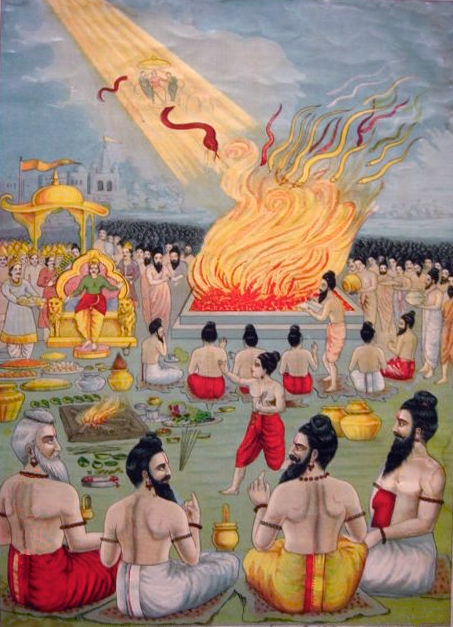
In Indian mythology, Nagas are described as semi-divine serpents who could assume serpent, human, or half-human and half-serpent forms. They were said to be possibly dangerous and incredibly numerous and so were sent by the creator, Brahma, to live underground in a splendid, bejeweled magic land, called Nagaloka (loka-world). The so-called “dangerous” Nagas were said to bite and kill people indiscriminately; and the so-called “good” Nagas were praised as virtuous and adherents of Dharma—they were favored by the gods and revered by people. A Naga killed King Parikshit, whose son Janamejaya, vowed to rid the earth of all the Nagas. In the snake sacrifice arranged by King Janamejaya, the Souti narrated the story of the events that led to the snake sacrifice, and the story of how it was stopped. This story is told in the Astika parva(episode) of the Mahabharata.
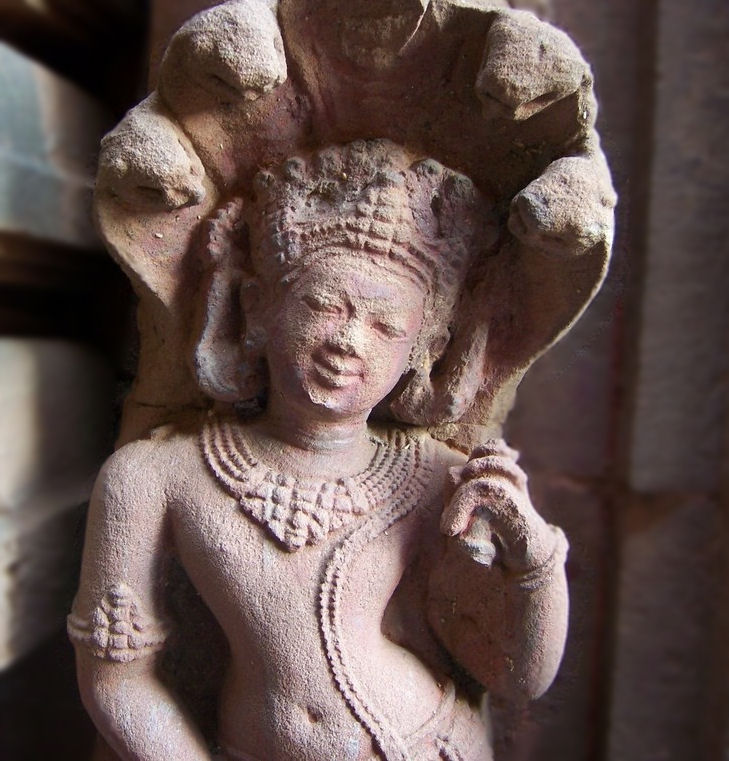
The story of the birth of Nagas and the curse are retold in Garuda’s story (Part 1 and Part 2), who is the half-brother of the Nagas. If you have not already, please read the stories to learn about their birth and the curse in more detail. I will quickly touch on the stories here too.
(For more on the Nagas and their history, listen to The Stories of India Retold Podcast! Available on all major podcast apps.)
A Mother’s Curse.
Nagas are the sons of Kashyapa and his wife, Kadru. Kashyapa was a powerful sage and was a Manasaputra (or son of the mind) of Brahma. Kadru was the daughter of Daksha, a rishi-king or divine-king, who was also a Manasaputra of Brahma. They were Garuda’s half-brothers.
Kadru asked Kashyapa for 1000 sons who were strong and powerful. When the time came, Kashyapa gave Kadru 1000 eggs containing embryos of their sons. Kadru incubated the eggs in steaming vessels and after a few months, the eggs hatched and the Nagas were born.
One day, Kadru and her sister, Vinata, who was also married to Kashyapa and was the mother of Garuda, entered into a wager. They got a glimpse of the famous Ucchaishrava, who was Indra’s horse. Kadru quizzed Vinata about the color of the horse’s tail. Vinata said it was white in color and suggested a wager. Kadru said that the tail was black in color and suggested that the one to lose the bet would be the slave to the other and Vinata agreed. The very next day they made plans to travel across the ocean to look at the horse so that they can determine the winner.
Determined to win the bet so as to not become Vinata’s slave as per the terms of their wager, Kadru told her Naga children to turn into strands of black hair and wrap themselves around the horse Ucchhaishrava’s tail. Kadru was shocked when her children refused to do her bidding and in anger she cursed her children and condemned them to die in the snake sacrifice conducted by King Janamejaya.
A mother’s curse was known to be powerful and true. The Naga brothers worried about the implications of the curse. If their mother’s words came true, then it guaranteed the decimation of their entire race. They wanted to find a solution to the seemingly unsalvageable situation. Different members of the Naga family handled the situation differently.

The first born of the Naga brothers, named Ananta or Shesha, was greatly disappointed with the behavior of some of the Naga brothers. Frustrated with their attitudes, he left the family and traveled to sacred places like Mount Gandhamadana, badari, Gokarna, the forests of Pushkara and the slopes of the Himalayas.
During this pilgrimage, Shesha chose to undertake intense meditation and conducted austerities. Shesha was so involved in his work as an ascetic that he wasn’t taking care of himself at all. When his grandfather, Brahma, saw him he was gaunt and thin and his hair was matted. Brahma urged him to stop living such an intense ascetic’s life because it was causing harm to all beings around him. Brahma asked him what he wanted to achieve. Shesha told Brahma that he wished to be away from his relatives because he wasn’t happy with the way they behaved and treated others—especially his half-brother Garuda. He declared that he would rather give up living than be part of their deeds.
Brahma was sympathetic towards Shesha’s suffering. He praised Shesha for chosing the path of Dharma and rejecting everything that stood for adharma. Brahma comforted Shesha by revealing that only the evil Nagas will be killed in the snake sacrifice and told him not to worry about his brothers who followed the path of Dharma.
Brahma granted Shesha a boon and Shesha asked that he wished to always stand for Dharma and peace. Pleased with Shesha’s commitment to Dharma and to everything good and pure, Brahma blessed Shesha and armed him with the task of holding up the wide earth. And hence, under Brahma’s instructions mother earth opened up to allow Shesha under the earth. Shesha held up the earth, keeping the everchanging and fluctuating sphere stable.
Brahma was immensely pleased because the task that Shesha had undertaken was an extremely important one, so he asked Garuda to act as a helper to Shesha whenever needed.
A Solution To The Curse.
Now, not all brothers handled the curse the way Shesha did. Vasuki, the wise king of Nagas, was a problem solver. He wanted to find a solution and accordingly he consulted with all the Nagas brothers from whom he thought he could obtain sound advice on the matter. He expressed to them his sadness and disappointment because it was their mother who commuted the curse, which made it harder to break it; and because their own grandfather, Brahma, did nothing to stop the curse. Nevertheless, Vasuki wanted to make sure to do everything he could to save his kin; and he wanted to do it quickly.
Many plans were formed and suggested. Some Nagas brothers wanted to plant themselves as learned Brahmanas or advisors of Janamejaya’s court and convince him to cancel the sacrifice. Some wanted to bite and kill the chief priest who would be responsible for conducting the sacrifice, or kidnap the king or even bite and kill him. The wise among the Nagas quickly and strongly denounced the use of violence to achieve their means. Some suggested staging a sabotage of the sacrifice by either putting out the sacrificial fires by turning into lightning charged clouds and raining down on the fires; or creating obstacles such as stealing the items like the ladle, which is necessary to conduct the sacrifice; or desecrating the sacrificial site with urine and fecal matter.
Vasuki was not satisfied with the solutions suggested, he worried that they were yet to come up with a solution that would keep them safe. Finally, his brother Elapatra shared what he knew. He comforted Vasuki saying that all is not lost yet. Elapatra revealed that when their mother had cursed them, he rushed to their mother and sat on her lap because he was scared and worried. And while he was sitting on her lap, he heard other gods talk with their grandfather about the curse and question him about why he did nothing to stop to curse. Elapatra said that Brahma told the other gods that the reason he remained quiet was because the Nagas were too many in number and they were creating an undesirable situation because many of them were cruel and caused harm to other creatures for no good reason. So, to keep the other creatures safe, he decided some of the Nagas must die. However, Brahma also made clear that only the Nagas who do not follow the path of Dharma were to die; he also revealed that a boy named Astika would help bring cure to the curse and save the Nagas.
Astika was to be born to a great rishi belonging to the Yayavaras family, who was named Jaratkaru and he was supposed to marry a girl who bore the same name as him. Incidentally, the Nagas had a sister by the name Jaratkaru. And so, it was decided that when the time came, their sister would marry the rishi in order to help them to put an end to the curse.
The Nagas decided to keep a close eye on sage Jaratkaru—the plan was to approach him with the request to marry their sister whenever the opportunity arose. They monitored his every move for a long time. However, there was no change, Sage Jaratkaru simply continued with his life as a dedicated ascetic.
He Was Hangry! Another Day, Another King, Another Curse.
Meanwhile, King Parikshit, son of Arjuna and father of Janamejaya, got himself into a spot of trouble. The 60-year-old Parikshit was a popular king. He was fair to all of his subjects irrespective of their caste and did all he could to help his more vulnerable subjects: the poor, the orphans, elderly and the disabled. Like his ancestors before him, hunting was one of Parikshit’s passions. One day, he was out in the forest hunting and his arrow struck a deer. Somehow, the deer managed to escape Parikshit. It was unacceptable for Parikshit to lose the prey he had shot, and hence, he set out in search of the deer. For hours Parikshit looked for the injured deer in the dense forest, but to no avail! The deer was nowhere to be found and to add to Parikshit’s frustration, he was thirsty, hungry and exhausted.
While he was still searching for the elusive deer, he saw a cow barn, and when he entered it, he saw a hermit sitting there.
Parikshit introduced himself and asked, “I am looking for a wounded deer, have you seen it?”
To Parikshit’s surprise, the hermit just looked at him without giving him a response. Parikshit was livid because he thought that the hermit was showing him disrespect. He saw the carcass of a snake on the floor nearby, picking it up by the tip of his bow, he placed the dead snake around the neck of the hermit. Still, the hermit did not react. A few moments passed and Parikshit’s temper cooled, he recognized what he had done wasn’t cool at all. He was too ashamed to stay there, so he immediately left back for the capital without a word, leaving the hermit sitting in the barn, with a dead snake wrapped around his neck.
Not long after that, the hermit’s son, Shringi, who was also a powerful rishi, got to know about what Parikshit had done to his father. Shringi’s friend, Krisha, told him how the King placed a dead snake around his father’s neck because the king thought he was insulting him by not responding; while in truth, unbeknownst to the king, the hermit was unable to respond because he was undertaking a strict vow of silence at the time. The short tempered Shringi immediately saw red. He hated the king for the way he treated his father and because Parikshit used a dead snake to insult his father, Shringi cursed the king, declaring that within seven nights King Parikshit will be killed by Takshaka, who was the lord of the serpents.
As soon as he could, Shringi went to see his father, who was still seated in the cow barn just as Parikshit had left him. When Shringi saw the sight of his father sitting with a dead snake wrapped around his shoulders, he was livid all over again. With tears in his eyes, he told his father how he had punished the king with a curse to pay for what he had done.
Shamika was appalled by what his son had done in his anger. He told Shringi that when a king did wrong, it was against their dharma as ascetics to punish them, because, it was the king who protected them. Shamika also explained to Shringi that Parikshit was thirsty and exhausted, and had no clue that he was on a vow of silence, and they must consider these facts before punishing the King so harshly.
In any case, it was too late to do anything, because the words were already said—the die was cast. Shamika still wished to do some damage control, so he sent his disciple, Gouramukha, to the capital to meet with the king and explain what had happened and tell him about the curse Shringi had punished him with in his anger.
When Parikshit heard Gouramukha’s message, he was distressed by what he had done to the good-natured Rishi. He was ashamed at his behavior and regretted acting rashly. He sent his sincere apologies to Shamika through Gouramukha.
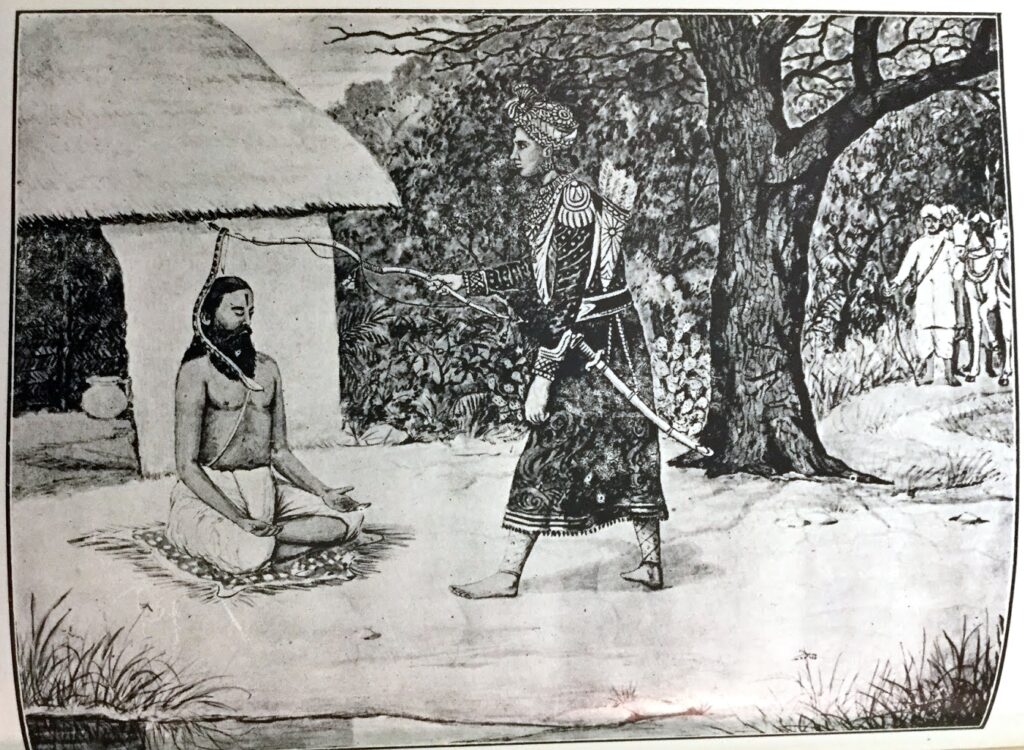
After Gouramukha left the palace, the King and his advisers put their heads together and made plans regarding how to stop the curse. To protect the king from Takshaka, they built a palace on pillars. Guards were posted around the newly built palace, who guarded the king day and night. Physicians and Brahmanas were on call to attend to the king with their medicines and mantras in case he needed them. With all of his defenses in place, Parikshit continued to perform his royal duties from inside the fortress he had built for himself.
The week had almost come to an end. Nothing out of the ordinary happened.
Death Of A King; Birth Of A War.
On the seventh day, Takshaka—who was on his way to the capital, and was thinking of a way to gain entry into Parikshit’s palace—saw the great Sage Kashyapa, who also seemed to be traveling to the capital. Assuming the disguise of an old Brahmana, Takshaka approached Kashyapa and struck up a conversation with him. Taskshaka asked Kashyapa where he was headed.
“I am going to the capital to meet the King. He will be attacked by Takshaka today and I have the knowledge to save him from the effects of the poison,” Kashyapa replied.
“I am Taskshaka,” he revealed to Kashyapa. “I will bite Parikshit today and he will not survive. Please go back home,” he told Kashyapa.
Kashyapa refused to return home. He told Takshaka that he was up for the challenge and was confident that he could cure the king because he had the knowledge and power to treat any kind of poison.
Taskhaka challenged him by biting a nearby fig tree, which caught fire because of the poison and burned down to ashes. Kashyapa accepted the challenge. From the ashes, he recreated the sapling; then he created 2 leaves, twigs and branches; in this way he recreated the entire tree.
Takshaka was greatly impressed by Kashyapa’s powers. Nevertheless, he told Kashyapa there was no way Parikshit would survive this attack since it was happening because of a Brahmana’s curse. Although hesitant to return, when Takshaka revealed to Kashyapa that the chances of Kashyapa failing was high because the curse was by a powerful Brahmana.
Takshaka said, “When you fail, you will lose your reputation as one of the most powerful and knowledgeable rishi. This isn’t worth the risk. Go back. I will compensate you with greater wealth than you would have ever received from Parikshit.”
Takshaka had read Kashyapa well. Kashyapa sought to cure Parikshit because it would be a challenging task and it would help cement his reputation as the most revered sages of the time; and because it would bring him greater wealth as well. Kashyapa considered Takshaka’s words, it was clear to him that Parikshit’s death was certain. So, Kashyapa decided to make most of the situation and accepted Takshaka’s offer.
With Kashyapa out of the picture, Takshaka put into action his plans to get access to Parikshit. Takshaka tasked some Nagas to go to the palace disguised as priests. He instructed them to tell the king that they had certain religious rites to perform, and—just as it was traditionally done—to present him with fruits and flowers at the end of the rites.
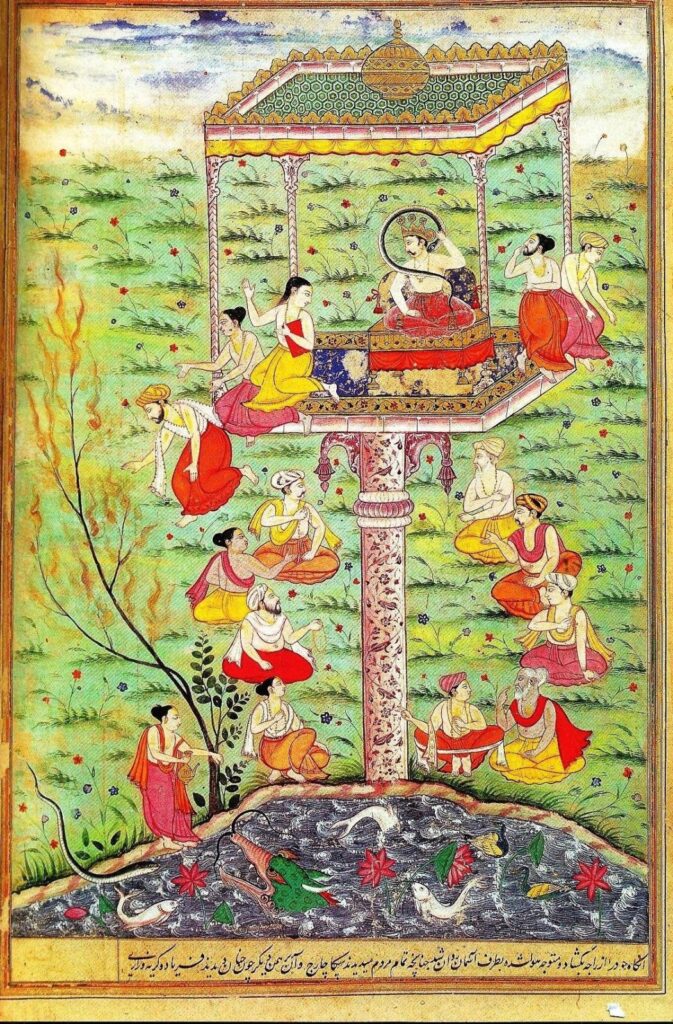
Just as planned, the Nagas were granted permission to enter the palace and at the end of the rites, they presented the king with the fruits and flowers they had brought with them.
Parikshit was in a celebratory mood. It was the seventh day and the sun was almost setting. Still, he was alive and well. Parikshit was feeling confident that he had successfully beaten the curse. He invited his advisors to share a meal with him. During the meal, he picked up the fruit he had received from the priests earlier and saw a tiny worm on it. It was a small worm with black eyes and copper body.
“Let this worm turn into Takshaka and bite me since a Brahmana has said so and his words should not be in vain,” Parikshit said. “The sun is almost setting; his poison will not kill me.” He picked the worm off the fruit and placed it on his neck.
Little did Parikshit know that he was tempting fate with his words. Because, you see, the little worm was actually Takshaka in disguise! No sooner than Parikshit placed the worm on his skin, it transformed into Takshaka in his serpent form, who immediately coiled himself around Parikshit’s neck.
Horrified by the scene playing out in front of them, the people around Parikshit watched helplessly. Fearing for their lives they began to flee the palace. Takshaka killed Parikshit and escaped by flying swiftly up into the air. After he fled, the fire from his attack spread and burned down the entire place.
The people of Hastinapur mourned the death of their king. He had served the country and it’s people well. After the funeral rites were performed, Parikshit’s very young son was crowned the new king. He was named Janamejaya.
When Janamejaya got older, he began questioning his advisers about the details of his father’s death. The advisors related to him all the details—from the curse on Parikshit, to the way Takshaka planned his attack. After listening to all of the details, Janamejaya, who was angry and distressed about the way his father was killed, decided that he would punish Takshaka. Janamejaya believed that Takshaka acted unfairly by stopping Kashyapa from helping his father and as a result robbing his father of an opportunity to survive the attack.
Janamejaya consulted with brahmanas and priests to discuss the best way to kill Takshaka. Because Takshaka killed Parikshit by setting him on fire, Janamejaya wanted to kill Takshaka similarly in a fire. The priests suggested a snake sacrifice, which was designed specifically for such a task. Janamejaya agreed and ordered for the sacrifice to be conducted.
So, what happened to the Nagas plans to stop the snake sacrifice from happening, you ask? Well… some time after the Nagas came to know that the key to stopping the curse lies in marrying their sister Jaratkaru to the sage Jaratkaru, and the son that would be born to them, they were alerted of the fact that sage Jaratkaru was looking to marry.
The Solution To The Curse Put To Action.
The Nagas kept a close eye on sage Jaratkaru’s activities. Sage Jaratkaru wasn’t originally keen on marriage; however, when he met with his relatives—who were valakhilya sages—they expressed great disappointment at a lack of heir in their family. The sages told Jaratkaru that they felt they had failed in their dharma because their line would end with them as Jaratkaru chose not to marry and produce children.
Not wanting to disappoint his relatives, Jaratkaru promised them that he would marry; however, she couldn’t depend on him to be maintained since he was an ascetic and had nothing, and that it would have to be someone with the same name as his.
The serpents who were spying on Jaratkaru heard this and they quickly related this piece of intelligence to the Nagas. The Nagas wasted no time and took their sister’s suit to sage Jaratkaru; and to the Naga’s delight and tremendous relief, Sage Jaratkaru accepted and they were soon married.
The two Jaratkarus started their married life in the beautiful palace of the Nagas. Very early on in their marriage Sage Jaratkaru warned his wife that she should take care because if she caused him displeasure, he would leave her. This made Naga Jaratkaru very sad but she accepted it and was extremely good to her new husband and took good care of him. One afternoon, Jaratkaru watched her husband as he was taking a nap with his head on her lap. He was taking a rather long nap, it was almost time for his evening prayers and he still wasn’t up. Naga Jaratkaru was faced with a dilemma: it was important to Jaratkaru to perform his evening rituals as it was part of his dharma, but he tended to have a temper and would not take kindly to being woken up from his nap. Naga Jaratkaru decided that dharma was more important and very lovingly woke her husband up.
Unfortunately for Naga Jaratkaru, Sage Jaratkaru did not take well to the fact that she woke him up from his nap. He took offense at the fact that she thought he would not wake up on time to perform his evening rituals.
“I do not want to be where I am insulted,” he raged at her and declared that he was leaving her because she had treated him with disrespect.
Shocked at her husband’s words, Jaratkaru defended herself. She told him that he was being unfair and she woke him up only because she was worried he would miss doing his dharma. She also argued that he could not leave before she conceived a child because it was important for the survival of her race and that was the why they married in the first place.
Nothing could stop sage Jaratkaru. Before leaving, he told her that she had already conceived, he could tell. And she had, in fact, conceived and she gave birth to a child who was named Astika (asti meaning ‘it is there,’ because his father said those words about his presence in his mother’s womb when she asked about their child)
Astika grew into a highly intelligent, responsible young boy. He learned the vedas and took care of his house; which pleased his Naga relatives immensely. His presence in their lives assured them that when the time came, he would do what Brahma had promised them and he would protect them from the curse.
And soon, the time came.
Birth Of A Child; End Of A War.
Under Janamejaya’s orders, the snake sacrifice was underway. Just as Janamejaya wished, and the priests had promised, one by one the snakes dropped into the sacrificial fire and died. There was wide-spread panic when the Nagas realized what was happening. A desperate Takshaka sought and received protection from Indra. Vasuki, on the other hand, was worried about his people and distressed over the deaths of thousands of his relatives. The sacrifice was beginning to show effects on him physically as well: he was feeling dizzy and could barely see. He made a plea to Jaratkaru to send her young son to the sacrifice to stop it and save their race.
Jaratkaru immediately called her son and told him about what was happening and how he was the key to putting an end to all the violence. Astika readily agreed to go to the sacrifice and do his best to stop it.
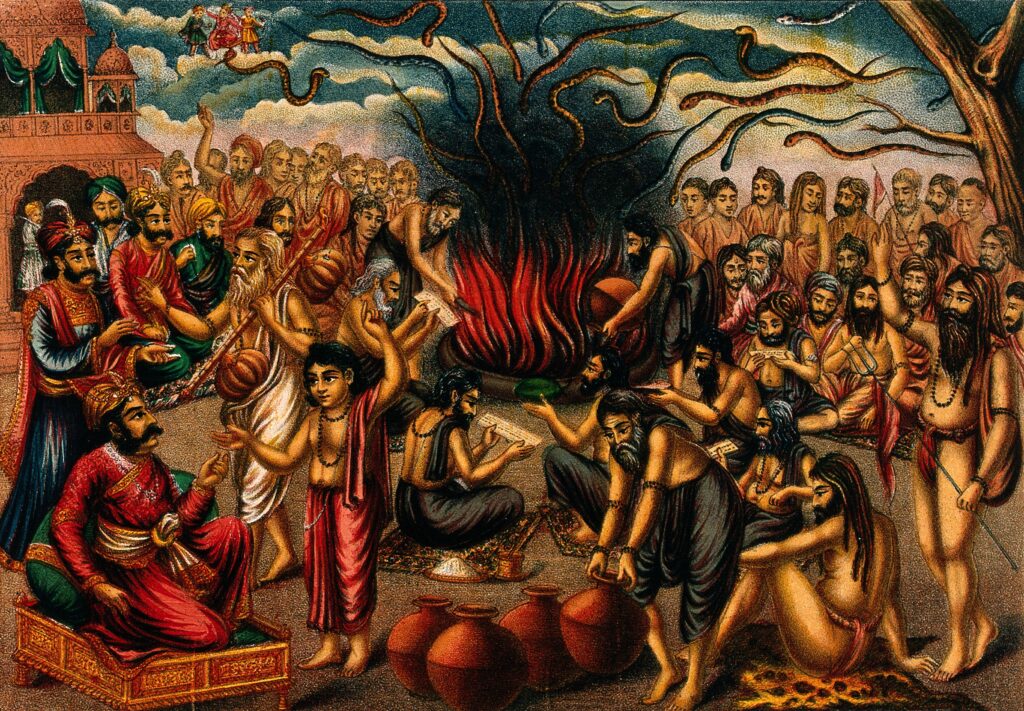
When he got to the venue of the sacrifice, Astika saw that it was a well-organized affair with great fires and many priests garbed in black involved in the sacrifice. It was an impressive sight. He approached the gates to enter the venue but was turned away by the guards.
Astika gained the attention of Janamejaya and the people present in the sacrifice by praising the king—he praised Janamejaya’s ancestors, he praised him as a powerful and just ruler, he praised him for his many virtuous deeds, he also praised the sacrifice. He spoke beautifully and Janamejaya and his men were very pleased with the words of the young boy. They were curious to know more about this intelligent brahmana who seemed wise beyond his years. Janamejaya was so impressed with him that he wanted to offer Astika a boon immediately. However, the officiating priest urged the king to wait till they get their hands on Takshaka.
Janamejaya agreed. “Where is he?” he asked.
The priests explained that Takshaka was with Indra and under his protection, which was why it was taking longer to reach him. Janamejaya ordered the priests to continue the sacrifice. As the fires raged on and the intensity of the rites increased, Indra realized he could not hide Takshaka with him much longer as the fire would affect him and his people too. So, he came to the sacrifice accompanied by the members of his court and an extremely reluctant and fearful Takshaka.
Soon, the priests reported to Janamejaya that Takshaka had started to suffer the effects of the fire: his body was weakening, he was losing consciousness and he was falling from the sky. Soon, they said, he would fall into the fire and that would be the end of him. They told Janamejaya he could focus his attentions on other things, namely, granting a boon to the wise, young brahmana at their gates.
Janamejaya asked Astika to join him. He praised him for his words and wisdom and offered him a boon. Astika asked him to call off the snake sacrifice and put a stop to the killing. At first, Janamejaya resisted.
“Ask for something else,” he pleaded with Astika.
Astika refused. He explained to Janamejaya that the serpents were his mother’s relatives and his wish was to see them safe.
After multiple attempts to sway Astika failed, Janamejaya reluctantly agreed to Astika’s wishes and called off the snake sacrifice. Just as Brahma said he would, Astika saved countless lives of his Naga relatives.
And this is the story of how a great number of Nagas were killed in the snake sacrifice and how they put a stop to it.
The End.
Visit The Stories Of India Retold Podcast to listen to the story and to learn more about the history of the people of the Naga tribe. Available on all major podcast apps.
References:
The Mahabharata 1: Complete and Unabridged; translated by Bibek Debroy. (2015). Penguin Random House India. (Original work published 2010)
Images:
Unknown artistUnknown artist, Brahma give boon to Shesha and order to bear the Prthvi or Earth, marked as public domain, more details on Wikimedia Commons
Wellcome Collection gallery, The serpent sacrifice. Chromolithograph. Wellcome V0045030, CC BY 4.0
Sujit kumar, Bishnu, CC BY-SA 4.0
Unknown artistUnknown artist, Snakesacrifice, marked as public domain, more details on Wikimedia Commons
Unknown artistUnknown artist, Kashyapa alive tree what is burnt by Takshak ( near Pond ) and parikshit bitten by Takshak, marked as public domain, more details on Wikimedia Commons
- What Drona & Arjuna’s Story Teaches Us About Success, Destiny
- See Why Shakuntala Says A Wife Must be Cherished
- Samudra Manthana:Story of the Quest for Immortality
- Ekalavya’s Tragic Sacrifice: Why The Archer Sliced His Thumb
- Dhritarastra, Pandu, Vidura: Birth; the struggle to revive a dying lineage.
- ©storiesofindiaretold copyright 2022 all rights reserved
